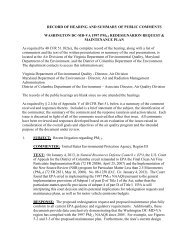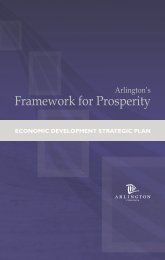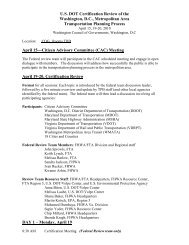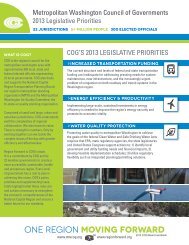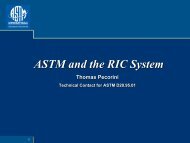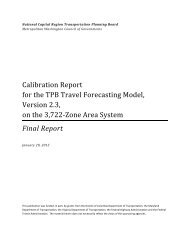PTI Local Government Energy Assurance Guidelines - Metropolitan ...
PTI Local Government Energy Assurance Guidelines - Metropolitan ...
PTI Local Government Energy Assurance Guidelines - Metropolitan ...
You also want an ePaper? Increase the reach of your titles
YUMPU automatically turns print PDFs into web optimized ePapers that Google loves.
There are a number of ways that local planners can allow for wind energy in their communities, including an outright<br />
permitted use; with a special use permit; subject to site plan review; and as an accessory use. 11<br />
Not all wind turbines are large enough to trigger the concerns discussed above. Distributed wind technology (DWT)<br />
applications refer to smaller turbine installations on the customer side of the utility meter. These machines range in<br />
size from less than one (1) kW to multi-megawatt, utility-scale machines used to offset electricity consumption at the<br />
retail rate. DWT can help energy assurance efforts through battery charging, powering remote telecommunications<br />
sites, and other applications.<br />
Key Questions<br />
…in Addressing Renewable <strong>Energy</strong> Technologies<br />
1. What are local utilities doing in the renewables area, and is it possible to participate in any of<br />
the programs that they are managing?<br />
2. Is it feasible to partner with other regional governments on a mass purchase of renewables that<br />
will bring down energy costs?<br />
3. What renewable technologies are already in place within the local jurisdiction and what type of<br />
experience has it (including other city departments) had with them?<br />
4. Which renewable technologies are best for the locality (wind, solar, geothermal, etc.)?<br />
5. Are there State, Federal, or private sector incentives offered for renewable technologies that<br />
could be used at the local level?<br />
6. Is there a public education program that should be implemented along with the renewable<br />
technologies that are under consideration?<br />
2.6.3. <strong>Energy</strong> Efficiency, Distributed Generation, and <strong>Energy</strong> <strong>Assurance</strong><br />
<strong>Energy</strong> efficiency and distributed generation are important to an EAP because cost-effectiveness is central to<br />
developing and implementing the plan. Because energy assurance is an emerging concern, it must compete for<br />
funding with many established programs, projects and services that local governments and the resident population<br />
and businesses rely on. The net effect is that energy assurance must find meaningful linkages to other priorities<br />
in order to leverage effectiveness and contain costs. Both energy efficiency and distributed generation have the<br />
capability of reducing the capital costs for any energy assurance investment, while also reducing ongoing operational<br />
costs by reducing facility demand for energy.<br />
<strong>Energy</strong> efficiency increases energy assurance by decreasing reliance on supplied energy, thereby resulting in a<br />
higher level of self-reliance. Distributed generation makes a positive contribution to energy assurance because<br />
these systems are typically relatively independent of the grid and can be used as primary or secondary sources of<br />
power. Emergency backup power as a form of distributed generation is an energy assurance asset because it can be<br />
dispatched in real time and with little effort in the event of a grid or onsite power generation emergency.<br />
11<br />
NYSERDA, “Wind <strong>Energy</strong>: Model Ordinance Options,” October 2005.<br />
20 | 2 – Issues to Consider When Developing a <strong>Local</strong> <strong>Energy</strong> <strong>Assurance</strong> Plan



